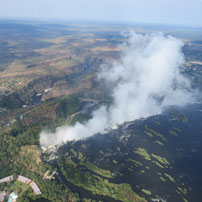 I don’t think it matters how many times you fly over Victoria Falls, nor that the scene below you may differ each time; that frisson of excitement followed by sheer wonder at the spectacle below remains the same.
I don’t think it matters how many times you fly over Victoria Falls, nor that the scene below you may differ each time; that frisson of excitement followed by sheer wonder at the spectacle below remains the same.
This time I was flying in with Ethiopian Airlines from Addis Ababa, a route that is becoming increasingly popular due to their expansive network across Africa, their modern fleet of aircraft and often competitive prices.
Victoria Falls is a bustling town with a vibrant energy and full of tourists who are drawn here to witness the natural wonder of the Falls themselves and, for some, to join in the many adrenalin fuelled activities on offer. Just thirty minutes away, however, is Zambezi National Park, an oasis of calm when compared to the town.
A stay within the park offers a multi-faceted experience with game drives, walks, canoeing and the ever popular sunset cruise all being possible in addition to visiting the Falls.
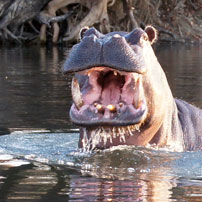
Dependent on where you stay, it is feasible to do a half day visit to the Falls. The newly opened Old Drift Lodge, its close neighbours Victoria Falls River Lodge and Island Lodge, plus the latest addition to Great Plains Conservation Portfolio, Mpala Jena, are all within thirty five minutes’ drive or boat cruise of the park gate making it possible to visit the Falls in the morning and get back in time to spend the drifting along the Zambezi. Access to the Falls from the lodges further upstream, such as Zambezi Sands and the luxurious Matetsi, does require a bit more effort and a longer day out but it can still be done.
After a couple of days in Zimbabwe, I crossed over the bridge into Zambia where the next two days were spent visiting some Safari Consultants favourites including Waterberry Lodge and the Islands of Siankaba, where the welcome was as warm as ever, and discovering some newer properties including Royal Chundu Island Lodge, the epitome of exclusivity and luxury situated some 40 kms. upstream from the Falls.
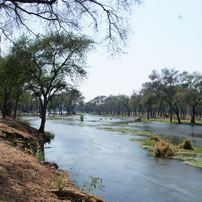
Activities on the Zambian side of the Falls can also be varied; cultural and historical tours, museum visits and trips across to Livingstone Island are all popular.
Whether you stay on the Zimbabwean or Zambian side of the Falls and whether you stay in town or in the bush, a stay close to Victoria Falls can be viewed either as a relaxing start to your trip after a long flight or as an excellent way in which to finish your safari with a few days of R & R.
From my very first visit I fell in love with Zambia. The contrasting landscapes have always appealed to me, and it would be hard to be disappointed by the game viewing, but for me the people have always been the special ingredient. Wherever you go you are met with smiles and a genuine warmth. It is also one of the last bastion of owner run camps in Africa with names such as Coppinger, Pope and Shenton all being stalwarts of the industry. What is genuinely pleasing is that this tradition of small owner run camps looks set to continue and in Luke Evans and Kyle Branch at Tusk and Mane Safaris and Phil Jeffery and Tyrone McKeith from the eponymously named Jeffery and McKeith Safaris, I would say that the future is in safe hands.
The Lower Zambezi National Park is incredibly beautiful. I don’t think I will even tire of 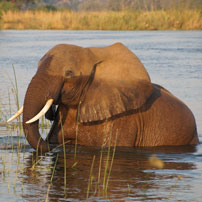 flying in there and having my breath snatched away by the vast Zambezi River snaking beneath me, dotted with sand banks where crocs bask in the sun and hippos wallow in the shallow waters. Someone once described it to me as being like an enchanted forest and it’s a description that comes back to me time and again. Bound to the south by the Zambezi River and the north by a densely wooded escarpment the park is a tapestry of riverine woodland, mopane fringed floodplains and open vleis interspersed with giant fig, mahogany and acacia trees. The way the light disperses through the trees gives the park an almost ethereal ambiance where handsome male kudus ghost amongst the trees, baboons forage and play on the ground and large herds of buffalo can suddenly emerge, as if from nowhere, from the tree line. Game concentration may not be as high as in the Luangwa Valley but this, for me, is still a little piece of game viewing paradise.
flying in there and having my breath snatched away by the vast Zambezi River snaking beneath me, dotted with sand banks where crocs bask in the sun and hippos wallow in the shallow waters. Someone once described it to me as being like an enchanted forest and it’s a description that comes back to me time and again. Bound to the south by the Zambezi River and the north by a densely wooded escarpment the park is a tapestry of riverine woodland, mopane fringed floodplains and open vleis interspersed with giant fig, mahogany and acacia trees. The way the light disperses through the trees gives the park an almost ethereal ambiance where handsome male kudus ghost amongst the trees, baboons forage and play on the ground and large herds of buffalo can suddenly emerge, as if from nowhere, from the tree line. Game concentration may not be as high as in the Luangwa Valley but this, for me, is still a little piece of game viewing paradise.
It has been a few years since I last visited the Lower Zambezi and it was good to visit old favourites including Chiawa, Old Mondoro, Chongwe River Camp and Amanzi.
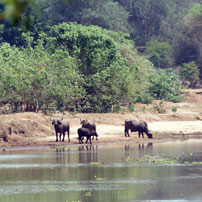 However, it was sleeping in a simple tent with only a bed, luggage rack and a single lantern that gave me my best night’s sleep on this trip. Floor to ceiling gauze on three sides of the tents, not only allowed for a welcome breeze during the hot October night but also allowed the sounds of the night to drift in. A frogs’ chorus, hippos splashing in the water, and the snapping and creaking of tree branches as the elephants fed nearby were my night time accompaniment. A discrete cough and ‘good morning’ was my wakeup call just as the sun appeared over the river and was shortly followed by fresh coffee and porridge cooked over the camp fire. This is old school safari as offered by Tusk and Mane Safaris and it was the highlight of my trip.
However, it was sleeping in a simple tent with only a bed, luggage rack and a single lantern that gave me my best night’s sleep on this trip. Floor to ceiling gauze on three sides of the tents, not only allowed for a welcome breeze during the hot October night but also allowed the sounds of the night to drift in. A frogs’ chorus, hippos splashing in the water, and the snapping and creaking of tree branches as the elephants fed nearby were my night time accompaniment. A discrete cough and ‘good morning’ was my wakeup call just as the sun appeared over the river and was shortly followed by fresh coffee and porridge cooked over the camp fire. This is old school safari as offered by Tusk and Mane Safaris and it was the highlight of my trip.
Luke and Kyle offer a highly personal safari and whilst game drives are an integral part of the experience, the emphasis really lies on exploring the area on foot and from the water, matched throughout with expert guiding and a sense of fun and adventure. Their mobile camp moves between two islands which offer a lovely contrast; Chulu Island which is dominated by Natal mahogany trees and has a slightly wild feel, and picturesque Kutali Island, covered by a winterthorn forest and regularly visited by herds of elephants. The waters around the islands can be explored by canoe, allowing guests to silently drift by 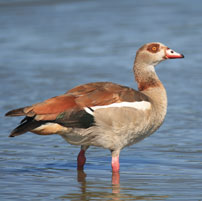 somnolent hippos or wallowing elephants or by boat, enjoying a cold beer as the sun sinks lower on the horizon or throwing out a line and seeing what bites. The islands are ideal walking territories; no vehicles, no other tourists and only birdsong and the wind in the trees breaking the silence. Walking here is both private and exhilarating. As I arrived in camp, guests were returning from a long morning walk, talking of how they had spent hours tracking a big male leopard whose tracks has been seen close to the camp that morning. As they returned to camp, still looking at the tracks, it became obvious that the leopard had never been far away and had been watching their every move. The trackers had become the tracked!
somnolent hippos or wallowing elephants or by boat, enjoying a cold beer as the sun sinks lower on the horizon or throwing out a line and seeing what bites. The islands are ideal walking territories; no vehicles, no other tourists and only birdsong and the wind in the trees breaking the silence. Walking here is both private and exhilarating. As I arrived in camp, guests were returning from a long morning walk, talking of how they had spent hours tracking a big male leopard whose tracks has been seen close to the camp that morning. As they returned to camp, still looking at the tracks, it became obvious that the leopard had never been far away and had been watching their every move. The trackers had become the tracked!
Tusk and Mane is a unique product in the Lower Zambezi and for anyone wanting just a taste of adventure it can easily be combined with one of the more luxurious camps in the Lower Zambezi such as the newly refurbished Sausage Tree Camp. Alternatively, it will work really well with a stay in the South or North Luangwa where walking camps such as Chikoko Trails or Mapazi (another excellent small outfit, owned and run by Deb Tittle who will have guided many of you in the Luangwa Valley over the years) will be natural stable mates.
After my stay in the Lower Zambezi, I travelled to the Kafue National Park, another consideration for anyone wanting a safari away from the masses. Here I spent three nights with Jeffery and McKeith Safaris.
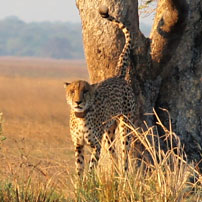
Kafue is often viewed as a destination for a second or third time visitor to Zambia as access has not always been straightforward (this remains true and I would urge anyone to pay a little bit more and to fly in as a preference to a six hour drive) and the density of game does not rival its competitors. On the plus side however, visitor numbers are low which further enhances an already amazing wilderness experience. The park is enormous (approx. 22500 sq. kms), and as such I was only able to visit a tiny portion of it, but even so the rich diversity of habitat, the rewarding game viewing and the variety of activities on offer was impressive.
As you travel through the park the terrain changes from riverine forest, miombo woodlands and open grasslands to the vast seasonal Busanga f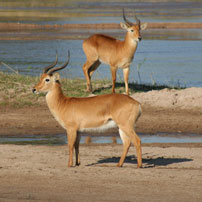 loodplains in the north. It is this medley of terrains that gives rise to an equally impressive diversity of animals with twenty different species of antelope including roan and sable, big cats, elephants, buffalo and hippo all resident in the park. Birding in the park is superb. As I was leaving, park news came through that a Fawn Coloured Lark has been spotted in the Nanzhila area. Whilst official accreditation has yet to be given, it seems likely that this will bring the official total of recorded bird species in the park to 500.
loodplains in the north. It is this medley of terrains that gives rise to an equally impressive diversity of animals with twenty different species of antelope including roan and sable, big cats, elephants, buffalo and hippo all resident in the park. Birding in the park is superb. As I was leaving, park news came through that a Fawn Coloured Lark has been spotted in the Nanzhila area. Whilst official accreditation has yet to be given, it seems likely that this will bring the official total of recorded bird species in the park to 500.
Phil and Tyrone have grown up in the bush and their passion for it is visible, not just in their conversation and their superb guiding but also in their conservation efforts to safeguard the future of the park. They operate two camps; Musekese which is tucked away in the north eastern sector of the park and the seasonal Ntemwa- Busanga Camp situated on the southern edge of the Busanga Plains. Both exude an authentic safari ambiance where like-minded people gather together around the fire at the end of the day and exchange stories of their days’ game viewing
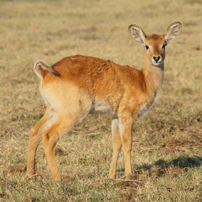
Hidden away in the tree line, Musekese overlooks a permanent lagoon which was constantly alive with wildlife. Like clockwork, herds of elephants passed by twice a day, on their way to drink at the river and hundreds of puku would simply sit motionless in the grass, trying to conserve their energy during the intense heat of the day whilst keeping a look out for predators.
It would have been easy to simply sit on the deck and watch the animals go by, but there was much more to discover with game drives, boat cruises and walking all available. When I look back on my stay, I will think of the shy little leopard that came to the river’s edge as we cruised by but who quickly scarpered, of the naughty young hippo who likes posturing at every boat that approaches and of watching the sun go down as the African Skimmers took flight.
My outstanding memory however was a morning walk led by Phil Jeffery. We left early, just two guests plus Phil and our scout and we walked along the tree line, stopping to look at tracks and to watch the birds. Soon however we became aware of a breeding herd of elephants and slowly by slowly, under Phil’s careful guidance, we made our way closer to them. Eventually, we stopped by a mound and there we sat for the next thirty minutes watching as the herd moved ever closer, stopping and starting and sniffing the air as they sensed our proximity. As we held our breath and dared not move, the herd ambled by within spine tingling reach and that is something I will never forget.
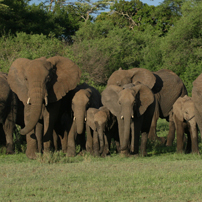
After a three hour drive north from Musekese I reached their more adventurous sister camp, Ntemwa Bushcamp. This is a seasonal bush camp which operates from the beginning of July to the end of October, situated on the edge of the remote Busanga Plains. During the rains, this whole area is under water and access becomes impossible, but once the waters recede it becomes one of Zambia’s wildlife hotspots. Hippos hide out in the permanent channels of water and large herds of red lechwe and puku are drawn to the lush vegetation along with buffalo, zebra and wildebeest, all of whom are prey to the resident prides of lions that patrol the plains.
This is a stunning part of the park and the expansive plains offer a great contrast to the area further south. Heading out on an afternoon game drive, the plains seemed empty until Tyrone’s eagle eyes spotted movement on the horizon and we were soon following a solitary male cheetah as he marked his territory on a solitary tree and there I sat, in the solitary vehicle out on the plains. That, for me, is part of the appeal of the Kafue; even though you might have to work a little harder to find the game, when you find it, you are likely to be alone!
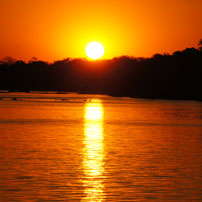
A safari in Zambia is never going to disappoint and there is something for everyone; luxury lodges or adventurous fly camping, walking in the bush or watching the animals from the comfort of a vehicle. What sets Zambia apart from other destinations though is the personal touch and the ability to still stay at owner run camps where the welcome is warm and personal and the guiding is superb.
Mary stayed at Old Drift Lodge, Chundu Island Camp, Royal Chundu Island Lodge, Tongabezi Lodge, Tusk and Mane Mobile Camping, Amanzi Camp, Musekese Camp and Ntemwa Busanga Camp.
Mary visited: Victoria Falls River Lodge, Victoria Falls Island Lodge, Mpala Jena, Matetsi Victoria Falls, Masuwe Lodge, Waterberry Lodge, Islands of Siankaba, Royal Chundu River Lodge, Sussi & Chuma Lodge, Toka Leya, Thorntree River Lodge, The River Club, Anabezi Luxury Tented Camp, Old Mondoro Camp, Chiawa Camp, Time + Tide Chongwe Camp, Time + Tide Chongwe House.
